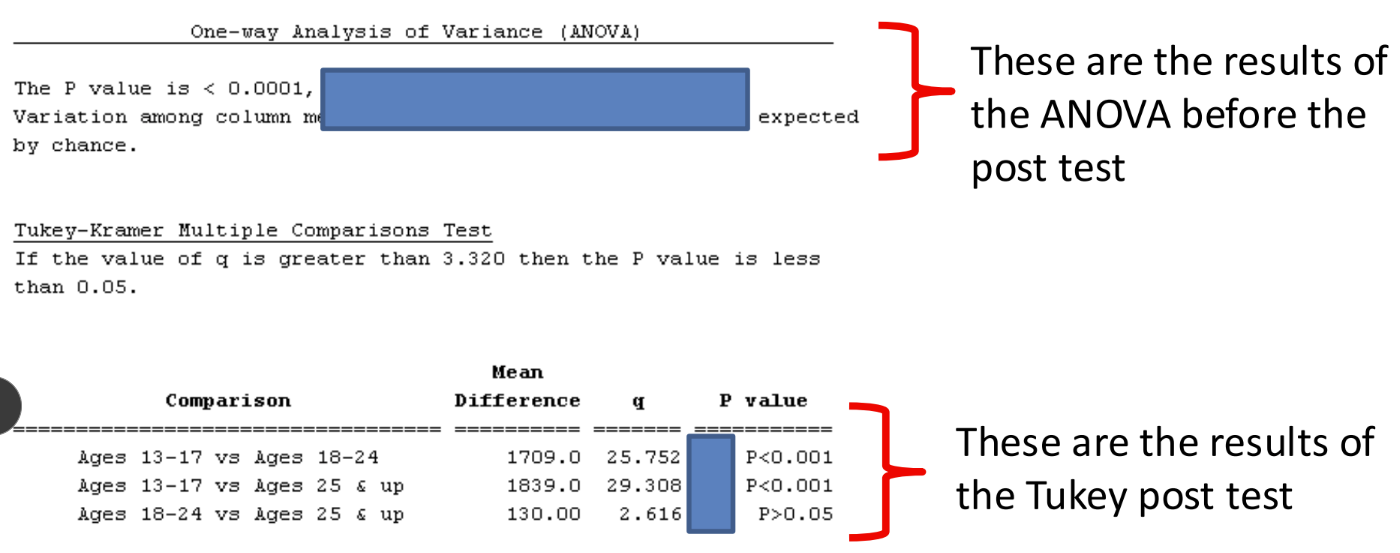ANOVA
1/12
There's no tags or description
Looks like no tags are added yet.
Name | Mastery | Learn | Test | Matching | Spaced |
|---|
No study sessions yet.
13 Terms
What is an ANOVA test
ANOVA = used for 3 or more groups/means
Describe a one-way ANOVA
One-way ANOVA = Design indicates one independent variable/factor (“one way”) WITH three or more levels and 1 dependent variable
Determines if observed differences among a set of means are statistically significant from each other
Based on F-statistic, instead of t-value
Ex: A researcher is studying the effects of different assistive devices on stride length in a population of above-knee amputees. There are three groups: control (no assistive device), cane, and crutches
Control vs Cane vs Crutches
Ex: measuring mean # of texts/month in three age groups
CLASS:
3 samples looked at for 1 dependent variable
3 groups compared

Describe a two-way ANOVA
Two-way ANOVA = Two independent variables/factors (each with 2 or more levels/categories) and one dependent variable
Looking for interactions between the independent variables
One drug may be more effective when combined with a specific diet
Ask 3 questions:
What is the effect of variable A, independent of variable B? (main effect)
What is the effect of variable B, independent of variable A? (main effect)
What is the joint effect of interactions of variables A and B? (interaction effect)
Ex: measure the effects of 3 drugs AND 3 diet regiments (both are independent) on blood pressure
Ex: measuring mean # of texts/month in three age groups in three different countries
CLASS:
more than 1 independent variable looking at 1 dependent variable

Describe a repeated-measures ANOVA
Repeated-measures ANOVA = one independent variable (multiple categories) and one dependent variable measured in the same subjects over multiple occasions
Analogous to the paired t-test (Within-subjects design)
Advantage of using repeated measures is that individual differences are controlled
Lower error variance than in randomized experiment
More powerful
Ex: measuring mean # of texts/month before school phone restrictions were implemented, after school phone restrictions were implemented, and after high school graduation
CLASS:
SAME SAMPLE BEING LOOKED AT 3 DIFFERENT POINTS IN TIME
when looking at more than 2 instances
Describe a Multivariate ANOVA (MANOVA)
Multivariate ANOVA (MANOVA) = one (or more) independent variables (with multiple categories) and two (or more) dependent variables
Includes MULTIPLE dependent variables
Detects pattens of values that result from the effects of multiple DVs that an ANOVA cannot detect
May be statistically significant when one or more of the ANOVAs are not significant, and vice verse
Ex: effects of 3 different medications on diastolic and systolic blood pressure (DBP, SDP)
There is one IV with 3 levels (3 different drugs)
There are two DVs (DBP & SBP)
Ex: measuring mean # of texts/month AND data usage/month in three age groups in three different countries
CLASS:
MORE THAN 1 DEPENDENT VARIABLE
doesn’t matter how many independent variables there are
ex: attention, reaction time, and memory for 3 different tutoring styles
Interpret ANOVA statistical output in context of a research question
What is the use of a multiple comparison test
Multiple comparison test = post hoc because specific comparisons are decided after the ANOVA is completed
Good for exploration of outcome/general hypotheses (post hoc)
Ex: Tukey’s, Newman-Keuls
Some are priori because specific comparisons are planned prior to data collection based on research rationale
Ex: Bonferroni t-test
What are the characteristics of various multiple comparison tests? (3)
Tukey (after)
Newman-Keuls (after)
Bonferroni (before)
Describe a Tukey
Tukey (after) = looks at a comparison of each group to each group to determine if the specific null for that pair can rejected
Establishes a “familywise” error rate, so that alpha identifies probability that one or more pairwise comparisons will be falsely declared significant
conservative
Describe a Newman-Keuls
Newman-Keuls (after) = specifies type 1 error rate for each pairwise contrast, rather than for the family
The number of comparisons increases, the chances of type 1 error are greater than with a Tukey
But is more POWERFUL. More likely to detect significant differences than Tukey
Describe a Bonferroni
Bonferroni (Before) = Priori test that uses familywise error rate, therefore as # of comparisons increases, each comparison has to achieve a lower p-value to achieve significance
Protection against type 1 error
Considered fairly conservative tests with high p-values
Interpret the results of a multiple comparison test in the context of the research question
Looking at picture:
Significance found in ANOVA, but the posttest found that there is no significance between 18-24 and 25 up group

Steps to pick the appropriate statistical test
Is comparison planned or unplanned?
If interested in exploring all possible combinations, unplanned contrasts should be used (Tukey or Newman-Keuls)
If asking “is this particular difference significant?” then use planned comparison (Bonferroni)
How important is the protection against type 1 and type 2 error?
Each post-test offers different error control
Newman-Keuls most powerful, but increases risk of type 1 error
Tukey provides reasonable power and protection against type 1 error (but increased risk of type 2 error)
Decisions should be based on the research question, not on which test is most likely to find significant differences!
Have reason for picking what you did
Choice is not always obvious